Sockeye Salmon Recipe
This sockeye salmon recipe is a delicious and healthy meal! This salmon is perfect for a quick and easy weeknight meal. It bakes for only 15 minutes. This sockeye salmon comes out hearty, tender, and juicy. The recipe is simple to follow and yields perfectly cooked salmon that is moist and flavorful. Great for weeknight family meals, special holidays, celebrations, and more!
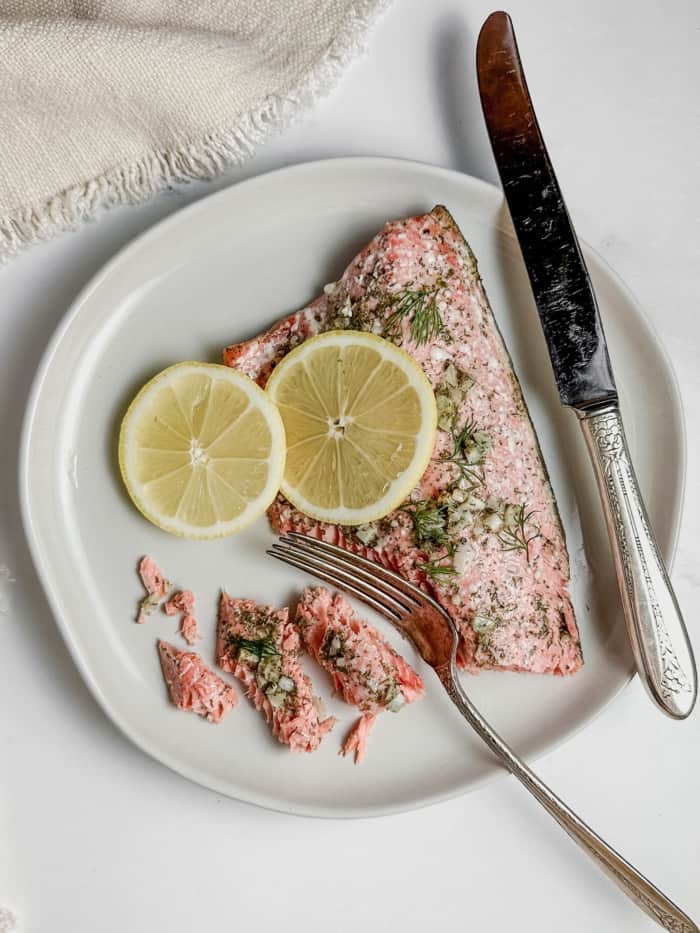
Why You’ll Love This Recipe
- This sockeye salmon recipe is quick and easy to make.
- Only 15 minutes of baking time needed.
- Sockeye salmon is a great source of omega-3 fatty acids, which are beneficial for heart health.
- This recipe is perfect for a weeknight meal. Try this healthy Halibut recipe too.
- It tastes like restaurant quality!
- The salmon is cooked to perfection. It is moist and flaky on the inside and slightly crispy on the outside.
- The simple seasonings of olive oil, lemon, and garlic bring out the natural flavor of the salmon.
- This recipe is versatile. It can be served with a variety of sides, such as roasted vegetables, rice, or pasta.
- This recipe is naturally Whole30 compliant, Paleo, gluten-free, dairy-free, egg-free, nut-free, and sugar-free. In addition, this salmon is Keto and low carb.
- Check out this Candied Salmon or this Yellowfin Tuna for another delicious dinner recipe!
What is Sockeye Salmon?
Sockeye salmon is a species of salmon that is native to the North Pacific Ocean.
It is known for its bright red flesh, which comes from its diet of plankton and crustaceans.
Sockeye salmon is a popular choice for seafood lovers because it is both delicious and healthy.
Here are some of the things that make sockeye salmon special:
- Flavor: Sockeye salmon have a more intense flavor than other salmon species. This is due to their diet, which consists of small fish, plankton, and crustaceans. The high fat content of sockeye salmon also contributes to their flavor.
- Color: Sockeye salmon have a bright-orange flesh that is due to the carotenoid pigments found in their diet. These pigments are also responsible for the red color of tomatoes, carrots, and other fruits and vegetables.
- Texture: Sockeye salmon has a firm texture that makes it ideal for grilling, baking, and smoking. It is also a good choice for canning.
- Nutrition: Sockeye salmon is a good source of protein, omega-3 fatty acids, Vitamin D, and Vitamin A.
- Sustainability: Sockeye salmon is a sustainable fish species. They are managed by strict fishing regulations in Alaska, where most of the world’s sockeye salmon are caught.
Ingredients & Substitutions
These are the main ingredients and substitutions for this homemade sockeye salmon recipe. Scroll down to the recipe card for full ingredients list and instructions.
Use the freshest salmon possible. Wild caught Alaskan salmon has superior taste. Feel free to use one large fillet or smaller fillets.
Olive oil helps marinate and tenderize the fish. If needed, use avocado oil.
Fresh lemon juice adds acidity and tartness to the salmon.
Minced garlic adds the classic garlicky flavor.
Use dried or fresh dill. This adds an earthy flavor to the salmon.
Both sea salt and pepper add a subtle flavor.
Garnish with lemon slices and fresh dill if desired.
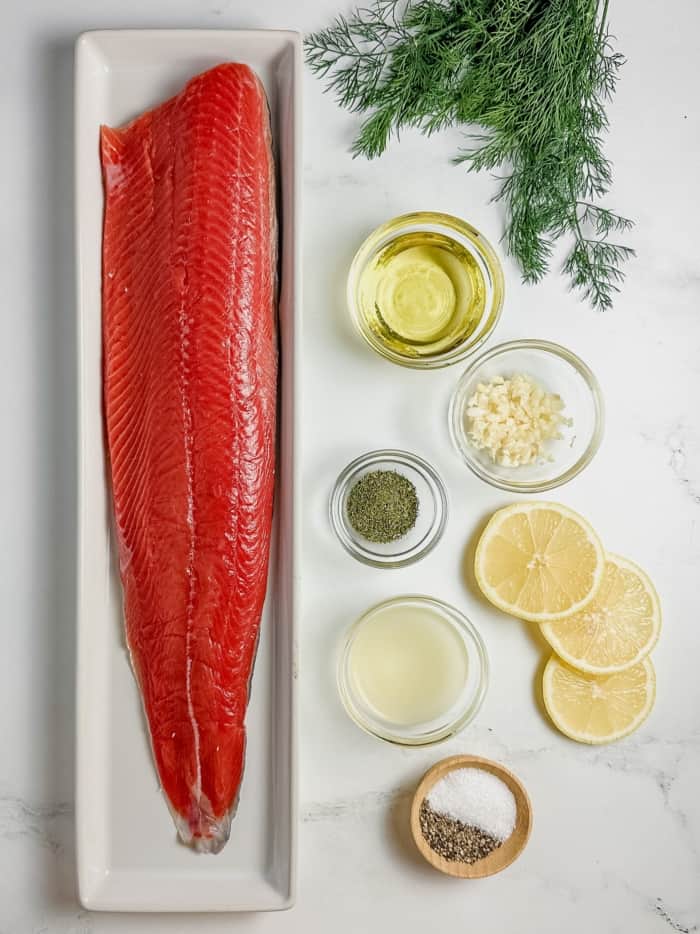
Taste & Texture
This sockeye salmon recipe has a rich, slightly smoky flavor. The flesh is firm and flaky, and it melts in your mouth.
Sockeye salmon is a versatile fish that can be cooked in a variety of ways. These ways include baking, grilling, poaching, and pan-frying.
How to Make
Step 1
First, preheat your oven to 375 degrees Fahrenheit.
Step 2
In a small bowl, mix together the olive oil, lemon juice, minced garlic, dill, salt, and pepper to create a marinade.
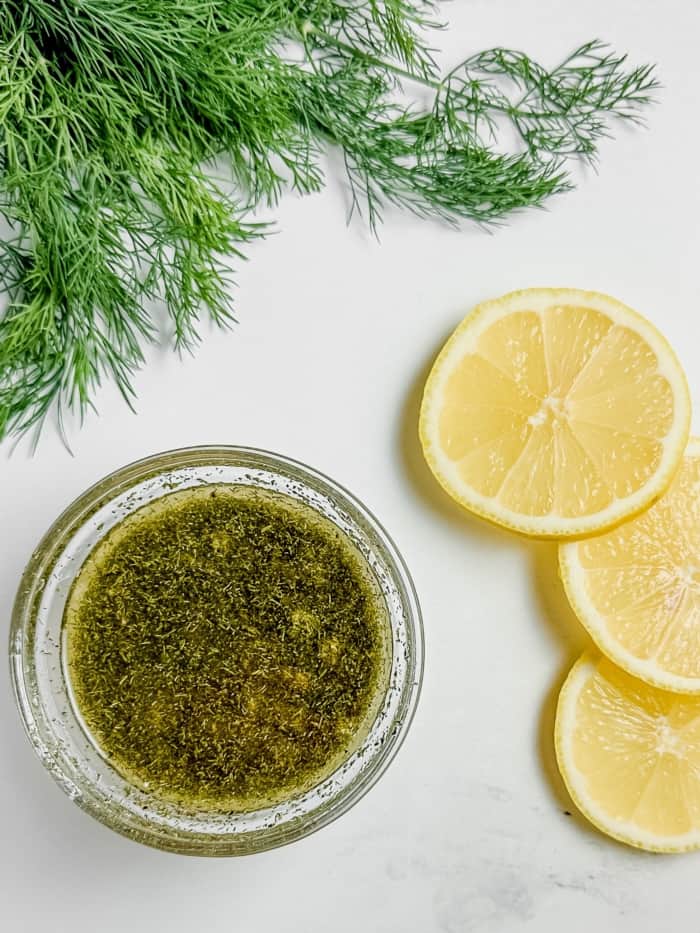
Step 3
Place the sockeye salmon in a baking dish. Pour the marinade over it and coat evenly. Let the salmon marinate in the fridge for 15 to 20 minutes.
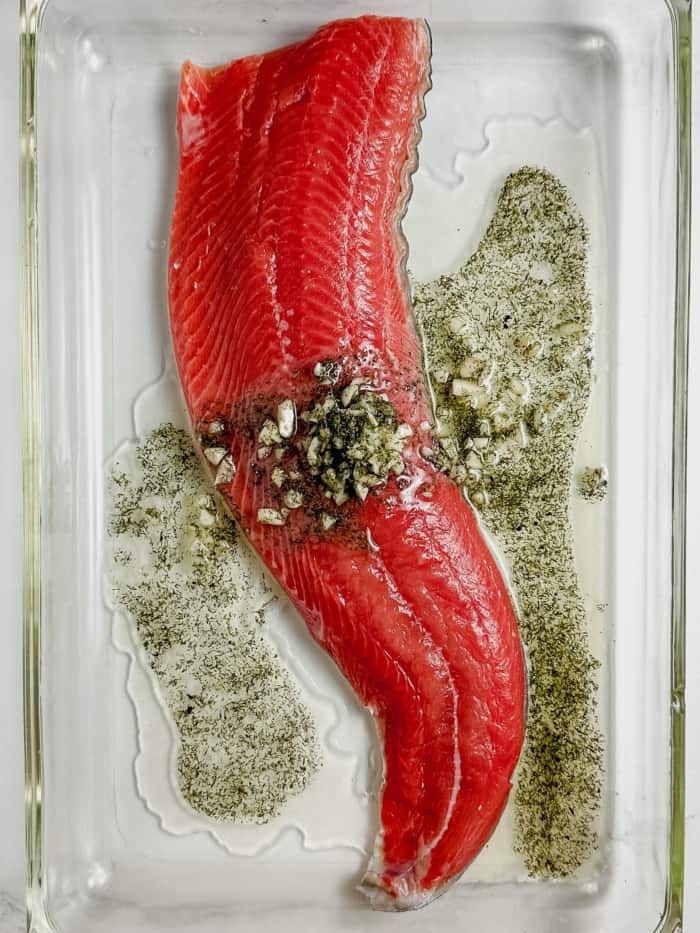
Step 4
While the salmon is marinating, line a rimmed baking pan or baking dish with parchment paper. Or, lightly spray with nonstick spray.
Step 5
After marinating, take the salmon out of the marinade. Place it in the prepared baking dish.
Step 6
Bake for 12 to 15 minutes, depending on the thickness of the fillet. The salmon should be cooked through and flake easily with a fork.
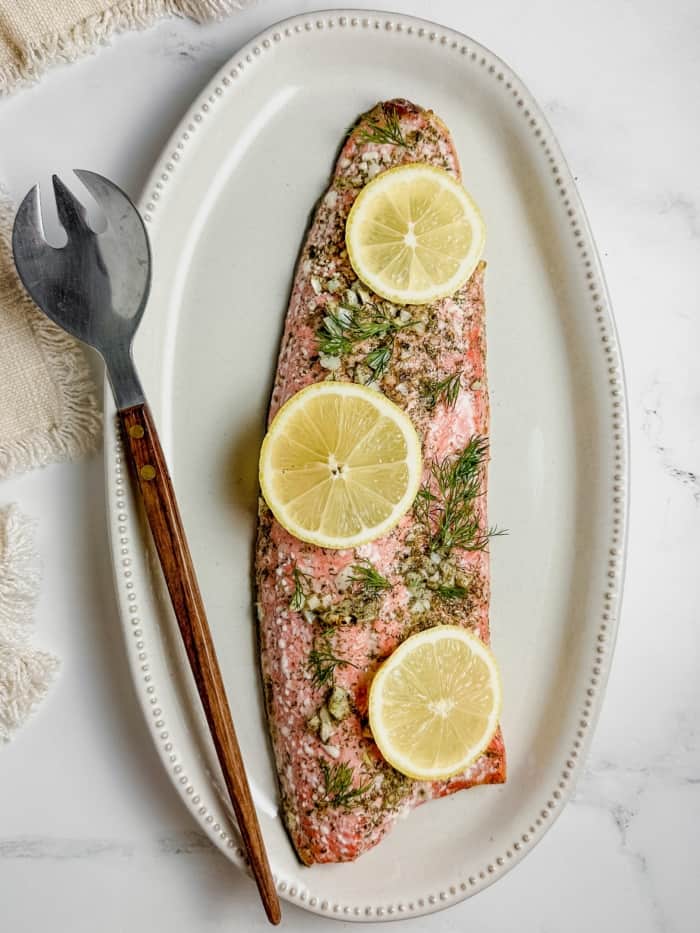
Step 7
Once the salmon is done baking, remove it from the oven. Let it rest for one minute.
Step 8
Finally, garnish this sockeye salmon recipe with lemon slices and fresh herbs if desired.
Expert Tips & Tricks
Use fresh salmon if possible. Wild caught from Alaska is best for this sockeye salmon recipe.
To ensure that your sockeye salmon is cooked to perfection, use a meat thermometer. Check that the internal temperature has reached 145 degrees Fahrenheit.
Do not skimp on the seasonings. Salt and pepper make a big difference.
If you are grilling your sockeye salmon, be sure to preheat your grill to medium-high heat. Cook the salmon for about 6 to 8 minutes per side, or until cooked through.
Sockeye salmon is also delicious poached or pan-fried. To poach your sockeye salmon, bring a pot of water to a simmer and add a tablespoon of salt. Place the salmon in the pot and poach for about 6-8 minutes, or until it is cooked through.
To pan-fry your sockeye salmon, heat a tablespoon of olive oil in a pan over medium heat. Add the salmon to the pan. Cook for about 4 to 6 minutes per side, or until cooked through.
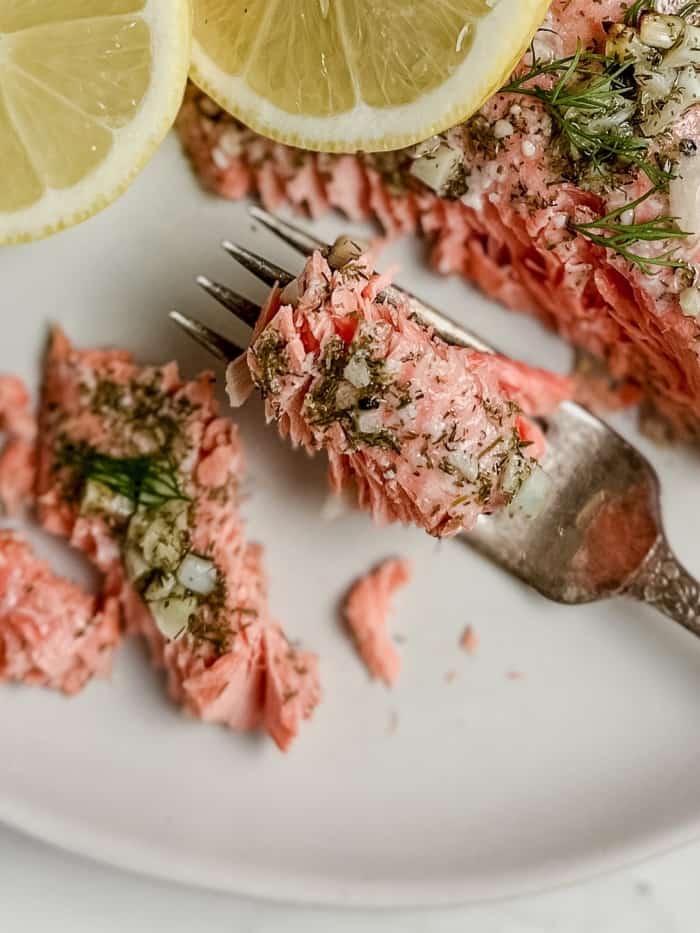
How to Serve & Store
This sockeye salmon recipe is delicious served hot or cold.
It can be served with a variety of sides, such as roasted vegetables, rice, or pasta. Sockeye salmon can also be used in salads, wraps, or sandwiches.
To store sockeye salmon, place it in an airtight container in the refrigerator for up to 4 days.
You can also freeze sockeye salmon for up to 3 months.
Difference Between Sockeye Salmon and Atlantic Salmon
Sockeye salmon and Atlantic salmon are two of the most popular types of salmon. They are both delicious and healthy, but they have some key differences.
Sockeye salmon is a smaller fish than Atlantic salmon. It has a bright red flesh, while Atlantic salmon has a lighter pink flesh. Sockeye salmon is also higher in omega-3 fatty acids than Atlantic salmon. For another salmon recipe, make this Cast Iron Salmon!
Sockeye salmon is typically more expensive than Atlantic salmon. However, it is worth the price for its superior flavor and nutritional value. This sockeye salmon recipe is incredibly flavorful!
Here is a table that summarizes the key differences between sockeye salmon and Atlantic salmon:
| Characteristic | Sockeye Salmon | Atlantic Salmon |
| Size | Smaller | Larger |
| Flesh Color | Bright Red | Light Pink |
| Omega-3 Content | Higher | Lower |
| Price | More Expensive | Less Expensive |
Frequently Asked Questions
Sockeye salmon is considered to be one of the healthiest types of salmon. It has a high concentration of omega-3 fatty acids, which are beneficial for heart health, brain health, and immune function. In addition, this sockeye salmon recipe also contains high levels of protein and Vitamin D.
Yes, all sockeye salmon is wild caught. There is no commercial farming of sockeye salmon. Sockeye salmon are an anadromous fish, which means they spend most of their lives in the ocean but return to freshwater to spawn. This makes them difficult and expensive to farm, as they require large tanks of seawater and access to freshwater.
Sockeye salmon are a type of salmon that are native to the North Pacific Ocean. They are wild-caught and only found in Alaska. Alaskan salmon is a general term that refers to any salmon that is caught in Alaska. This can include sockeye salmon, as well as other types of salmon, such as king salmon, coho salmon, and pink salmon. Sockeye salmon are typically smaller and have a brighter red color than other types of Alaskan salmon. They are also higher in omega-3 fatty acids and lower in mercury than other types of Alaskan salmon.
You can buy it at several different places. Fishmongers, grocery stores, and online retailers are great places to look. In addition, you can also buy directly from fishermen.
Sockeye salmon are in season from June to September in Alaska. The peak season is typically in July.
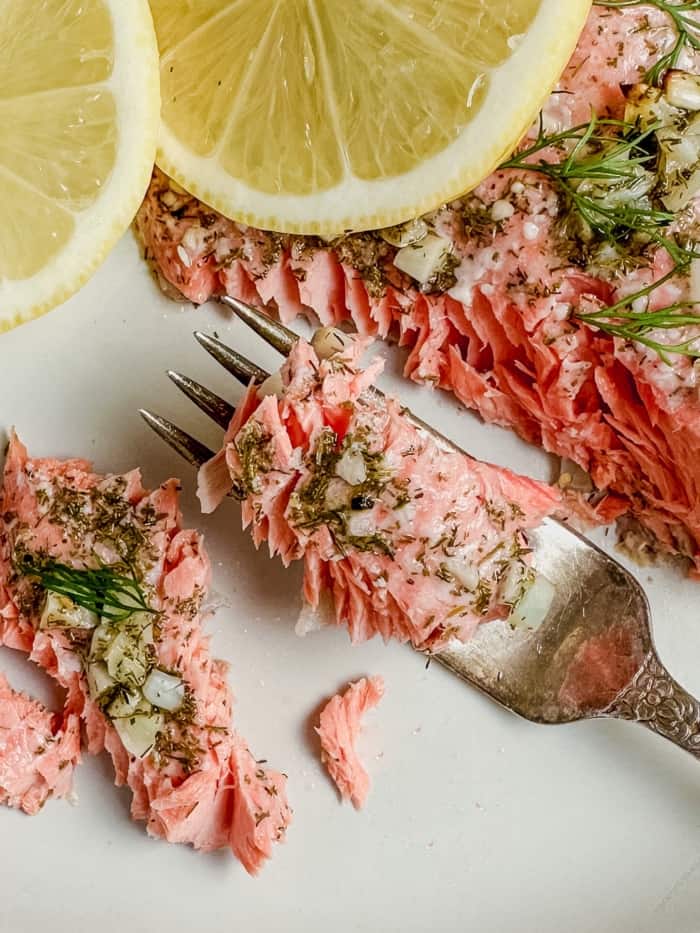
Equipment Needed
Staub Baking Dishes: I love these baking dishes for making this sockeye salmon recipe.
Check out all of my kitchen favorites!
You May Also Like
If you make this sockeye salmon recipe, I would really appreciate a review! You can find me on Instagram, Facebook, and Pinterest. Join my exclusive Facebook Group for a behind the scenes look. I would love for you to follow along! For more ideas, see these Lunch and Dinner Recipes.

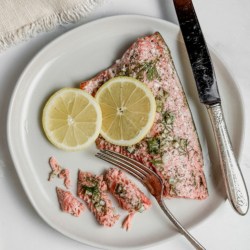
Get the Recipe: Sockeye Salmon Recipe
Ingredients
- 12 ounces sockeye salmon fillet
- 2 tbsp olive oil
- 2 tbsp fresh lemon juice
- 2 garlic cloves, minced
- 1 tsp dill, dried or fresh
- ½ tsp sea salt
- ½ tsp black pepper
- lemon slices, to garnish
- fresh dill, to garnish
Instructions
- First, preheat the oven to 375 degrees Fahrenheit (190 degrees Celsius).
- In a small bowl, mix together the olive oil, lemon juice, minced garlic, dill, salt, and pepper to create a marinade.
- Place the sockeye salmon in a baking dish. Pour the marinade over it and coat evenly. Let the salmon marinate in the fridge for 15 to 20 minutes.
- While the salmon is marinating, line a rimmed baking pan or baking dish with parchment paper. Or, lightly spray with nonstick spray.
- After marinating, take the salmon out of the marinade. Place it in the prepared baking dish.
- Bake for 12 to 15 minutes, depending on the thickness of the fillet. The salmon should be cooked through and flake easily with a fork.
- Once the salmon is done baking, remove it from the oven. Let it rest for a minute.
- Finally, garnish with lemon slices and fresh herbs if desired.
Notes
- Feel free to use one large 12 ounce fillet or two smaller 6 ounce fillets.
- Use fresh salmon if possible. We love wild caught Alaskan salmon.
- If you are in a time crunch, even a 5 minute marinade adds flavor.
- Do not bake too long. The fish should flake easily with a fork when done.
- Use a meat thermometer to determine the internal temperature of the fish.
- Store leftovers in an airtight container for up to 4 days in the fridge.
Love this healthy sockeye salmon recipe? You can sign up here to receive healthy meal plans, exclusive new recipes and updates!

6 Comments on “Sockeye Salmon Recipe”
I’m just learning how to cook and this recipe is right up my alley – I loved it!! Served it over brown rice and it was perfect!! Thank you!!
This is a brilliant quick dinner recipe. Zesty, tender and absolutely delicious. I’ll be making it again for sure!
I can’t believe how juicy this came out! Even my kids enjoyed it and I love how quick it whipped up, great for school nights.
We love sockeye salmon here and try to eat it at least once a week. It’s always nice to find quick and easy ways to prepare it like this recipe that taste great. The lemon juice and garlic make it flavorful without needing a crazy amount of ingredients.
I recently had time to make this sockeye salmon recipe, and it turned out so delicious! It was also family-approved, so I would love to recommend giving this a try!
This was the best salmon I’ve ever had! It was so moist and flaky, and the flavor was incredible. The lemon juice really brought out the natural sweetness of the fish.